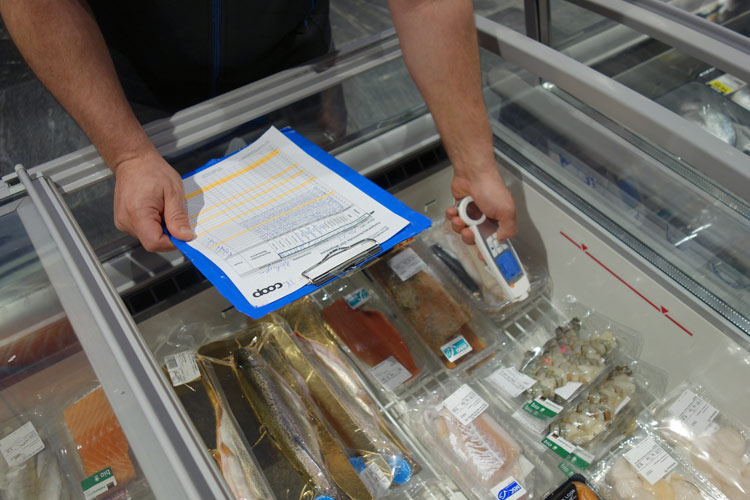How Coop is using IoT to ensure food safety
Today, the focus is more and more on ensuring the highest food quality and reducing food losses. Consistent cooling during transport and at the points of sale plays a decisive role. Together with its long-standing partner Swisscom and Gimasi, Coop has pursued an innovative approach to achieving these objectives: developing its own high-tech sensors that guarantee reliable food safety along the entire cold chain.
Automated cold chain monitoring E2E for Coop 5 Min.
- E2E temperature monitoring
- No manual readings or human error
- High measurement accuracy, temperature behaviour similar to food
- Integrated into the logistics process
- Alerts almost in real time; different alert modes
- No data loss
- Temperature sensor tailored to customer needs with a long battery life and remote transfer of temperature data via LoRaWAN
- Integrated temperature compliance monitoring of commercial refrigeration and ready-to-plug refrigeration units
- Route monitoring via gateway
- Automated E2E cold chain monitoring
When customers shop in a Coop store, they trust that the quality of the products is right and that they have little to worry about in terms of food safety. But how exactly does the retailer guarantee this safety? It covers a wide range of aspects, from procurement to logistics and sales. Proper refrigeration along the entire supply chain, combined with precise documentation in accordance with legal requirements, plays a decisive role.
Complex manual control
Until now, temperature control at Coop has been a complex process: sales staff had to manually check every day that the products were stored correctly and at the required temperature. This manual process was not only prone to error, but also inefficient as temperature deviations were not detected in real time. ‘It was very expensive and therefore unpopular,’ explains Silvio Raggini, Head of Quality Management at Coop.

Manual inspection of products
Logistics faced similar challenges: refrigeration monitoring required significant resources. A temperature logger was attached to the goods to be transported and recorded the temperature every five minutes. When the goods arrived at the point of sale, an employee had to stop the logger and fill in a separate form giving details of the assortment delivered and the place and time. This data was then manually transferred to Excel to document it for food control and internal quality management. All logger data was later analysed to determine whether temperatures during transport were acceptable. ‘During the summer months, these measurements were carried out more frequently, generating around 20 to 30 data sheets per distribution centre every day,’ explains Sascha Scherer, Head of Intralogistics Systems/Processes at Coop.
New IoT solution for greater efficiency
To overcome these challenges, logistics, IT and quality management launched a joint IoT project for automated temperature measurement. The main objective was to increase efficiency while ensuring the highest level of food safety. As part of this project, Coop, together with Swisscom and Gimasi, developed a modular sensor that can easily meet extended requirements.
Refrigeration unit monitoring at points of sale
The point-of-sale sensor transmits the measured data to mobile handheld devices in the points of sale in near real time, so that employees are immediately informed of critical temperature deviations. For example, they can see when and for how long a refrigerator door remains open, whether an appliance was accidentally switched off, or if there was an interruption in cooling. ‘We now detect such mistakes very quickly. This saves a lot of energy and allows for timely corrective action,’ explains Gian Marco Borsari, Head of Service Centre OT, Coop IT.

Refrigeration unit monitoring at points of sale (VST-sensor)
Cold chain monitoring 2.0
For logistics, a new sensor has been developed that monitors the temperature during transport and immediately sends a notification to logistics and the point of sale when critical temperatures are reached.

Cold chain monitoring 2.0 (logistics sensor)
Reliable data transmission via Low Power Network (LPN)
Data is transmitted via Swisscom’s Low Power Network (LPN), which has been specially developed to transmit small amounts of data over long distances. This ensures reliable data transmission even in areas with limited mobile coverage. ‘The Low Power Network is perfect for our needs: it is very reliable, cost-effective and transmission even works through concrete walls,’ says Gian Marco Borsari.
Swisscom solution framework architecture
The sensor data collected is fed into a Swisscom solution framework architecture for Coop, where it is processed before being integrated into Coop’s IT system. As a result, the company now has an accurate data history and can respond quickly and efficiently to critical temperature fluctuations if required. Felix Wunderer, Head of IoT and B2B Mobile at Swisscom, emphasises the importance of actively involving employees in such a large project: ‘It is crucial not only to focus on the technical aspects, but also to fully involve employees.’ This enables logistics staff to use their familiar scanners for the new IT solution without having to learn to use a new device.
Multiple benefits, high efficiency
‘The introduction of this new IoT solution has made working life at Coop significantly easier,’ emphasises Silvio Raggini. ‘In addition to the automatic generation of reports on temperature measurements during transport, the company now has a precise flow of data thanks to continuous data recording.’ Sascha Scherer sums up the benefits from a logistical point of view: ‘This innovative solution offers significant added value in terms of quality and efficiency.’ The modular design of the Swisscom sensor and software also enables Coop to use this solution in other business areas, such as building automation. ‘Swisscom’s continuous development of the sensor software (firmware over-the-air update/FUOTA) now makes it possible to equip all sensors with new features at the same time – an innovation that is unique on the market,’ emphasises Gian Marco Borsari.
Overall, implementing this digital solution has not only improved the quality and safety of Coop’s food products, but has also increased efficiency and made work easier for employees.



